The Panasonic KX-TGP600 is the newest iteration of the TGP series of DECT phones from Panasonic. As a cordless IP phone solution, the TGP600 offers increased mobility and versatility for wireless phones. And its ability to handle eight simultaneous calls is pretty mind boggling compared to the bare bones entry-level phones we've reviewed in prior months.
The TGP600 offers:
- 1.8-inch, 65,000-color TFT display on a cordless handset
- 200 hours of standby time and 11 hours of talk time
- Support for up to eight DECT handsets and up to eight SIP registrations
- High-quality wideband voice
- Up to 500 contacts in phonebook
The TGP600 is stacked with a bevy of features that make some SIP phones look like paperweights. But is this a phone package that's worth the price tag? We took the TGP600 for a spin to find out.
(Note: The Panasonic TGP600 is prepackaged with the KX-TPA60 handset. This review was undertaken using the TPA60 unless otherwise noted).
First Impressions of Panasonic’s Cordless IP Phone
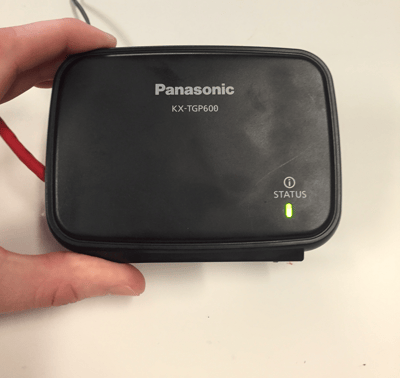
The TGP600 is smaller than the TGP500, and (like the TGP500) only the standard LED light lets you know what’s going on with the unit. A continuously blinking yellow light can mean many different things, which makes the initial setup frustrating for lack of clear direction. But the green light clearly means that the device is functioning properly, so after some trial and error, you should not have a problem getting the TGP600 up and running.
Other than this awkward lighting scheme, setup is relatively easy, and you can mount the TGP600 in an out-of-the-way location. But dealing with two power chargers, one for the TGP600 and one for the handset, will take up a sizable amount of space on your wall socket. So be prepared to unplug other appliances. Keep this in mind when you're buying more handsets because a few more surge protectors might be in your future.
There are three different handsets that are compatible with the TGP600. We were sent two of them for this review: the KX-TPA60 and the KX-TPA65.
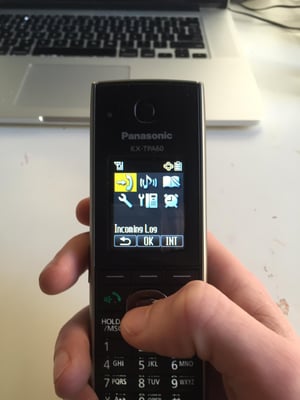
The TPA60 is what you’d expect from a DECT handset. It is compact and mobile enough that you can clip it onto a belt or shirt so that it remains with you when you need it. The screen is sleek and colorful, and the characters are sharp and well defined. The TPA60 might pay homage to some of the domestic handsets that people use in their homes, except this handset is clearly designed for business use.
We were able to take the TPA60 from one end of the floor of our office building to the other without any drop in quality or connectivity. It was only when we carried it to a sealed trash room that we lost radio signal. When we walked the phone back into range, it quickly re-registered itself to the base again. The range of the device keeps calls from dropping off as long as you are engaged in usage that does not clearly impede the call’s path.
The function buttons were located in the lower Function key on the right side of the phone, rather than near the top where you find the soft keys, which was somewhat inconvenient. The battery life is great. We left the phone out of its charger for five days, and it was still at more than 60 percent power.
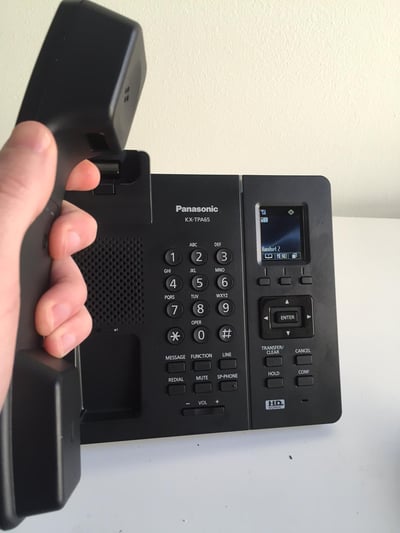
The KX-TPA65 is a less traditional wireless handset option. It is ultimately a wireless endpoint that looks and acts like a desk phone. It pairs just like a mobile handset, but it requires being plugged into a power outlet to function properly. The screen is the same as the TPA60. The TPA65 feels light and hollow, but the phone does not seem to be cheaply made or poorly designed. But the concept seems strange—why attach a wireless handset to a base that is designed for a desk phone?
Features
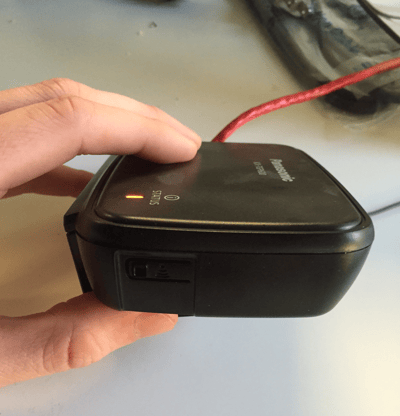
The TGP600 supports up to eight simultaneous SIP registrations. This could conceivably power eight different devices, such as the KX-TPA60, the prepackaged phone that comes with the TGP600. It was actually pretty amazing to undertake eight simultaneous phone calls on the TGP600. We've hardly ever seen a DECT offering as robust as this, and the TGP600 could definitely power an entire small business.
The range on the TGP600 is solid, and we were able to move from office to office without losing the signal. We did not notice an appreciable drop in call quality when we stretched the range of our office space. However, Panasonic offers a repeater that can build a mesh by using the KX-A406. The A406 allows you to have an effective range of nearly an additional 100 feet from the TGP600 base station.
The TGP600 itself only has one button on its facade: a finder function that rings all the phones registered to the device. It makes sense from a design standpoint, since the cordless phones are much more apt to get lost. Some critics may say that the TGP600 is limiting the user's options by excluding more featured buttons from its repertoire. But the overall experience of the TGP600 largely rests with what kind of handset you use with the device.
The KX-TPA60, the prepackaged phone that comes with the TGP600, has little in the way of traditional features. Two buttons appear on its front face: a transfer button and a hold button. Redial, Do Not Disturb, Recall, Auto Answer, Conferencing, Call Logs, and Paging are the remaining features, which are all found in the Function button. These features compare favorably to entry-level phones, but the TGP600 can hardly be classified as such. It costs $100 more than many entry-level devices. But on the other hand, the TGP600 does support up to eight devices. So it might be worth the cost if you're in much need of mobility or think you will end up tethering several phones to it.
Voice Quality
The voice quality on the TGP600 sounds perfectly fine. It certainly did not blow us away—we always hear the best of the best on desk phones. But as far as wireless phones go, the TGP600 seemed to offer an intelligible sound quality that clearly conveyed the content of our conversations. There was hardly any static or other attenuating noise that diminished our capacity to communicate.
The phone supports G.722, but it also supports G.722.2, which is similar to G.722. SIP to SIP conversations were great—true HD voice calls that showed off the firepower of high-quality wideband audio. We could compare the overall quality of the phone to some mid-level Grandstream desk phones that we have reviewed in the past.
Compatibility Testing
At OnSIP, we put each of the phones we use through a multi-step interoperability test in which we apply ~30 test cases. Here’s an example of a test case:
Test phone calls phone B
B picks up
B puts test phone on hold
B calls phone C
C picks up
B transfers test phone to C
The call must be transferred correctly to C. B must be released correctly after the transfer. When C picks up, audio must work both ways between test phone and C. When the test phone is on hold, there is no audio between it and phone B.
We did not experience any issues during our tests with the Panasonic TGP600.
Phone Configuration
Step 1: Gather information for each user.
Each user has a set of credentials that will be needed to configure each phone. For each phone that you are configuring, obtain the following credentials. You can find this information in the user detail pages under the Users tab in the Phone Configuration section.

Step 2: Log into your Panasonic phone through a web browser.
When your phone is powered on and connected to your LAN, use a browser to navigate to your phone’s IP address.
Step 3. Enter your user information from Step 1.
For most setups, you will need to configure "Simple Setup." If you are trying to configure multiple users or multiple line appearances, you can repeat the steps below for each of the identities you are configuring. You can insert boot.onsip.com as the provisioning server to save time on provisioning.
- Server Address: Domain
- Authentication User: Auth Username
- Authentication Password: SIP Password
- SIP Address: Username
- Display Name: Whatever You Like
- Proxy Server Address: sip.onsip.com
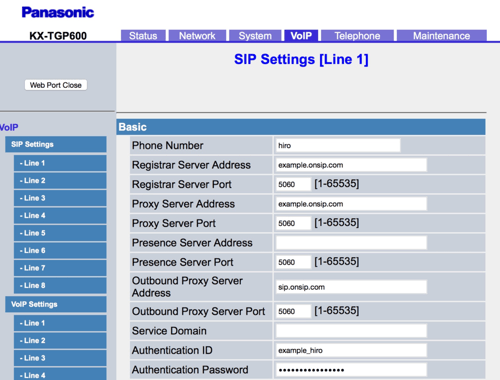
Step 4. Confirm that your phone is registered.
In the User portal, click on the "Users" tab. You will see a green "online" notation next to each user with a registered phone.
You should now be able to place and receive calls.
Final Thoughts
The Panasonic TGP600 offers exceptional mobility, versatility, and capacity with its impressive range and its ability to support eight devices at once. The TGP600 allows you to stretch your work space. It gives you the freedom to take calls from just about anywhere in the office. It also works great as a hub for a small business operating with up to eight people.
A large part of the TGP600 experience rests with what handset you sync up with the device. The KX-TPA60, the prepackaged handset that comes with the TGP600, leaves something to be desired in the realm of features. But that's ultimately the trade-off you encounter when you purchase the TGP600. Freedom of movement comes with a decreased feature set and a higher price.
Ultimately, the phone should be used by people who plan to primarily make basic voice calls. For the same price, users can buy desk phones with more commanding feature sets and better voice quality. But as far as DECT phones go, the TGP600 is at the top of its class. If you're in need of a cordless phone solution, the TGP600 should be somewhere at the top of your list.

